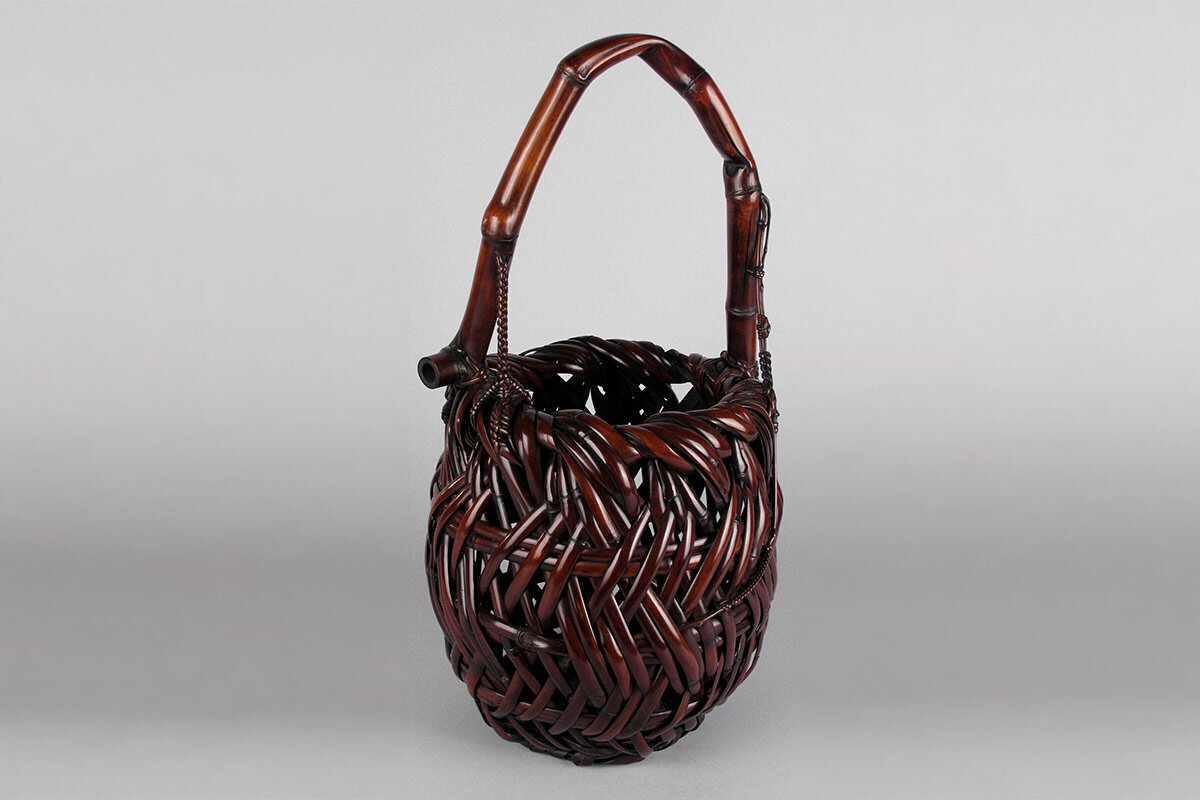BASKETRY
TANABE CHIKUUNSAI I, SMOKED BAMBOO FLOWER BASKET TITLED: CROUCHING TIGER
Flower arranging basket in an ovoid form surmounted by a tall angled handle. Woven of purple-brown smoked and split bamboo, the handle of bend smoked branch bamboo. Signed on the reverse with an incised signature by the artist: Chikuunsai Kore wo Tsukuru or Made by Chikuunsai (Tanabe Chikuunsai I, 1877 – 1937). Late Taisho – Early Showa Era, circa 1920 – 1930.
With the tomobako or original box, inscribed on the exterior of the lid: Kinmei Chiku Basho Ami Hana-kago, Kofuku or Golden Bamboo Banana-leaf Plaited Flower Basket, (Titled) Crouching Tiger; and on the reverse of the lid signed: Sakai Fu Nanso, Chikuunsai Kore wo Tsukuru or A House Facing South (in) Sakai, Made by Chikuunsai, and sealed: Chikuunsai.
Chikuunsai wove this masterpiece at the height of his career, using the most beautiful of materials available. The color of the smoked bamboo glows. On the box lid the reference to basho weaving is a poetic way of referring to his abstracted version of hemp leaf pattern (asa-no-ha) in the body. An ornamental banana that grows in relatively low bush-like clumps, basho were favored in literati gardens and paintings for the romantic way the long leaves waved and tore. Its fibers were also used to weave the highly prized Okinawan summer fabric, bashofu. Visually the reference echoes in the way Chikuunsai arrays diagonal strands in series of two, three or four so that they sweep left and right upwards through the sides of the basket. Through these stays broader horizontal strands of split bamboo encircle the basket on three levels. The vertical strands gather in swirling diagonal simple wrapping (bo-maki) at the rim, a treatment at first glance common enough. However all depends on proportion and the flowing strength that balances the rim and the body. From the sides a section of branch bamboo arcs upward, bent suggestively to echo the hunched shoulders of a crouching tiger. Two small finger branches run down on one side of the handle across the face of the basket, anchored by a long line of fine insect wrapping (mushi-maki) at the bottom. A heavier version of insect wrapping ties this finger branch to the rim, while an even more muscular line runs from the rim on the opposite side up to the handle in opposition to the finger branch. Other ornamental knotting includes one large elaborate cross knot (juji-musubi) and a small double interlocking ‘V’ knot, a restrained use of the classical weaving vocabulary.
Chikuunsai became famous for this style of flower basket, yet this is by far the most beautiful example we have seen.
Tanabe Chikuunsai I, Smoked Bamboo Flower Basket Titled: Crouching Tiger
Artist Name: Tanabe Chikuunsai I
Period: Taisho Showa
Mediums: Bamboo
Form: Basket
Origin Country: Japan
20-1/4” high x 10-3/4” wide x 11” deep
This piece is no longer available.








